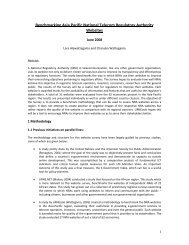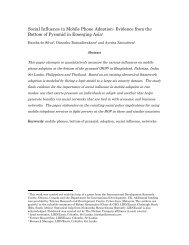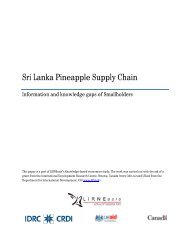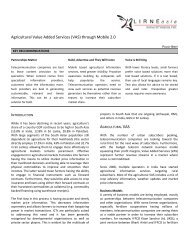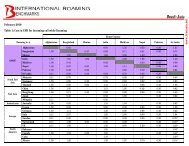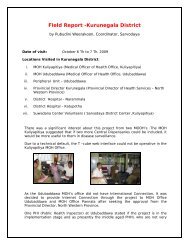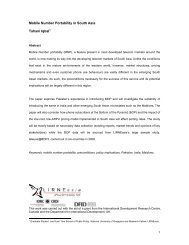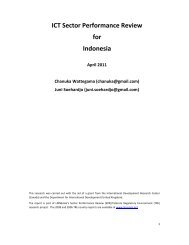Teleuse@BOP3: A Qualitative Study - LIRNEasia
Teleuse@BOP3: A Qualitative Study - LIRNEasia
Teleuse@BOP3: A Qualitative Study - LIRNEasia
Create successful ePaper yourself
Turn your PDF publications into a flip-book with our unique Google optimized e-Paper software.
several tasks remotely but the nature of these tasks is more personal than professional. For instance, a male<br />
‘Jeepney’ (a jeep-bus) driver receives texts from his customers to pick them up from a certain location in Philippines.<br />
Another respondent who repairs windows will receive calls as well as text messages from his boss to reach a<br />
particular location where he is to start work. Conversely, in the urban female group discussion we can note a<br />
respondent whose phone is a medium between her sister who is an overseas Filipino worker (OFW) and her<br />
children. The respondent is taking care of her sisters’ children in her absence and her phone serves the purpose of<br />
coordinating with the sister. Another respondent who is working and thus can not stay at home during the day time is<br />
using her phone to coordinate with her eldest son who is responsible for taking care of her younger children while<br />
she is at work.<br />
Male BOP respondents in Thailand are found to be using their phones for entertainment purposes more than the<br />
female BOP respondents. Male respondents prefer to play games and listen to songs on their mobile phones more<br />
often than the female respondents. Again, like in Philippines, the top contacts of the male BOP respondents are<br />
primarily from their work. Either they are in constant touch with their bosses or communicating with their colleagues<br />
and customers. Thus their primary usage of mobile phones is work related. They do use their phones to stay in touch<br />
with friends and family but mainly they seem to be using their phones to coordinate their work. Sammy, who is a<br />
mechanic by profession, mentions that he has to call the spare parts shop owner at least 5 to 10 times a day to<br />
enquire about the availability of various parts that he requires. On the other hand he calls his mother and brother only<br />
once in two days. Female respondents also have professional contacts listed in their top contacts but their usage<br />
revolves around calling their boyfriends or mothers and friends more often than they call their colleagues or other<br />
people related to their work. Thus there is a clear cut difference in usage of mobile phones in Thailand where<br />
females are found to be using it more to manage their social and personal networks while the male respondents are<br />
making use of the mobile phones to manage their work.<br />
This is also true for most of the South Asian countries. However, in Bangladesh though males claim to have bought<br />
their phones to stay in touch with their family, their mobile usage patterns clearly indicate that they are using their<br />
phones more for business than for social reasons. The female respondents seem quite clear in their reasons to buy<br />
mobile phones where they are buying phones to manage their social networks and are using it for the same reasons.<br />
Gender based discussions on telecom usage also need to deal with female usage of public phones as well as<br />
changing social perceptions around women’s use of mobile phones.<br />
In India, unlike in any of the other countries in South Asia, we see a clear preference in the use of public phones<br />
among female respondents. Women are using these phones to make calls in case they do not have access to mobile<br />
phones or landline phones or they are using the public phone to supplement their mobile use when their phone credit<br />
nears an end. Unlike Bangladesh and Pakistan, where female respondents clearly indicate that using public phones<br />
is difficult and socially criticized, in India, women are using public phones on a regular basis with the most frequent<br />
35




